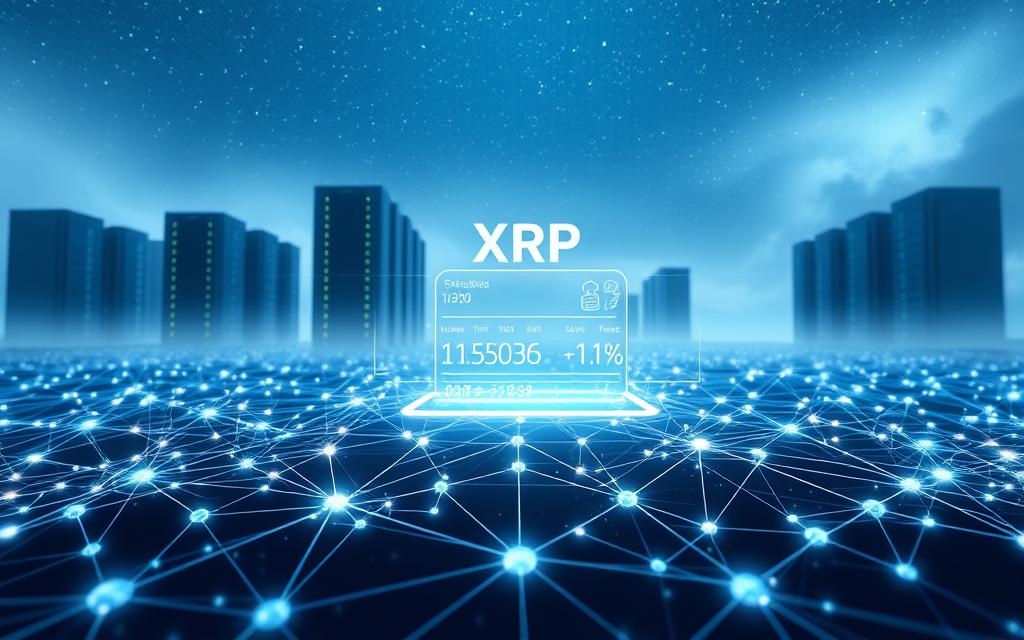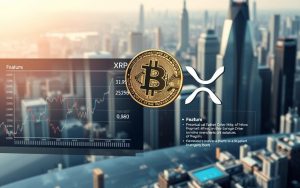Table of Contents
Ripple Labs introduced XRP in 2012 as a digital asset designed for fast cross-border transactions. Unlike decentralized alternatives, this currency operates with institutional efficiency, serving as a bridge between traditional financial systems.
The network processes 1,500 transactions per second—far surpassing conventional banking speeds. With 4-second confirmations, it enables real-time settlements between financial institutions worldwide.
Only 100 billion tokens exist, with roughly half currently circulating. This fixed supply creates scarcity while supporting liquidity needs across markets. Ripple’s technology complements fiat currencies rather than replacing them.
Legal challenges from the SEC remain a key consideration for potential investors. However, the asset continues gaining adoption among banks seeking efficient international payment solutions.
What Is XRP Crypto? Understanding the Basics
Originally conceived in 2004 as RipplePay by Ryan Fugger, the project transformed into OpenCoin before becoming the Ripple network we know today. Founders Jed McCaleb and Chris Larsen officially launched the platform in 2012 with a clear focus—bridging traditional finance and digital transactions.
Definition and Origin
Unlike most decentralized cryptocurrencies, Ripple operates under corporate governance. The system relies on a unique HashTree consensus protocol instead of blockchain. This approach eliminates energy-intensive mining while ensuring rapid transaction validation.
The ledger contains 100 billion premined tokens, with no additional coins created through mining. This fixed supply model differs sharply from Bitcoin’s capped mining structure. Institutions favor this predictability for liquidity management in cross-border payments.
Comparison With Other Digital Currencies
Ripple’s validation method processes transactions in seconds, outperforming Ethereum and Litecoin. The network serves as a SWIFT alternative rather than competing directly with other cryptocurrencies. Over 300 financial organizations use RippleNet for instant settlements.
Key distinctions include:
- Corporate oversight vs. decentralized development (like Bitcoin)
- Energy-efficient consensus protocol replacing proof-of-work
- Predefined token allocation instead of gradual mining rewards
For deeper insights into Ripple’s operational framework, explore this detailed guide.
How Does XRP Work? The Technology Behind It
Built for speed and efficiency, the XRP network processes payments faster than traditional banking systems. Its architecture bypasses energy-intensive mining, relying instead on a decentralized group of validators to confirm transactions in seconds. This design addresses scalability challenges faced by older blockchain models.

The XRP Ledger and Consensus Protocol
The XRP Ledger uses a unique HashTree consensus mechanism, where validators compare cryptographic hash values rather than full transaction histories. Unlike proof-of-work systems like Bitcoin, this method requires minimal energy—just 0.0079 kWh per transaction.
Key advantages include:
- Byzantine Fault Tolerance: Validators agree on ledger states even if some nodes act maliciously.
- No mining: All 100 billion tokens were pre-mined, with releases controlled by escrow.
- Energy efficiency: Uses 99.9% less energy than Bitcoin per transaction.
Transaction Speed and Scalability
The network confirms payments in 4–5 seconds—far surpassing Bitcoin’s 10-minute average. Real-world tests with MoneyGram show it handles 1,500 transactions per second (TPS), nearing Visa’s 24,000 TPS capacity.
Ripple’s roadmap aims to scale throughput further while maintaining stability. The system’s design ensures fees remain below $0.01, making it ideal for high-volume institutional use.
Key Features of XRP
Unlike traditional digital assets, XRP operates without mining—a key distinction in its economic model. This design eliminates energy-intensive processes, making it a sustainable choice for institutional transactions.
No Mining Required
The network validates transactions through a consensus protocol, not proof-of-work. This approach reduces energy use by 99.9% compared to Bitcoin. Validators confirm payments in seconds, avoiding the delays and costs of traditional mining.
Environmental benefits include:
- Low carbon footprint: 0.0079 kWh per transaction.
- No hardware waste: Unlike ASIC-dependent networks.
- Scalability: Handles 1,500+ transactions per second.
Fixed Supply of 100 Billion Tokens
All tokens were created at launch in 2012, with no new coins generated. Ripple holds 48 billion in escrow, releasing 1 billion monthly since 2017. This controlled distribution prevents inflation, unlike Ethereum’s uncapped supply.
“Our escrow strategy ensures predictable liquidity while protecting market stability.”
The 100 billion cap creates scarcity, similar to Bitcoin’s 21 million limit. However, XRP’s burn rate (0.00001 per transaction) adds a deflationary twist. Critics note Ripple’s centralized control over 46% of the supply, but proponents argue this stabilizes prices for institutional adoption.
| Feature | XRP | Bitcoin | Ethereum |
|---|---|---|---|
| Total Supply | 100 billion | 21 million | Uncapped |
| Inflation Control | Escrow releases | Halving events | Variable issuance |
| Energy Use/Transaction | 0.0079 kWh | 707 kWh | 62 kWh |
XRP’s Role in Financial Institutions
Major financial institutions now leverage XRP to streamline global transactions. Over 300 partners, including Santander and Standard Chartered, use RippleNet for instant settlements. This adoption highlights the asset’s utility in modern banking systems.
Bridging Traditional Banking and Digital Assets
Bank of America patented an XRP-based settlement system, signaling trust in the technology. Corporate treasuries benefit from Nostro account optimization, reducing trapped capital. The network’s compliance features meet strict regulatory standards, easing institutional integration.
Key advantages for banks include:
- Cost efficiency: MoneyGram cut transfer fees by 50% using On-Demand Liquidity (ODL).
- Speed: Settlements take under 5 seconds vs. SWIFT’s 1–2 days.
- Scalability: Processes $15B+ in cross-border transactions annually.
Cross-Border Payments and Liquidity
SBI Remit uses XRP for the Japan-Thailand remittance corridor, slashing fees and delays. Case studies show up to 60% lower liquidity costs compared to traditional methods. Central Bank of Montenegro tests CBDC interoperability, exploring future applications.
| Feature | XRP | SWIFT GPI |
|---|---|---|
| Speed | <5 seconds | 1–2 days |
| Cost per Transfer | $0.01 | $25–$50 |
| Energy Use | 0.0079 kWh | N/A |
“ODL eliminates pre-funded accounts, freeing billions in working capital.”
Advantages of Using XRP
Financial institutions gain significant benefits from XRP’s optimized transaction framework. The network delivers institutional-grade performance through measurable advantages in cost, speed, and sustainability.

Low Transaction Fees
At $0.0002 per transaction, fees are 7,500x cheaper than Bitcoin’s $1.50 average. Traditional wire transfers cost $25–$50 for similar cross-border settlements.
High-volume users realize substantial savings:
- MoneyGram reduced payment costs by 50% using On-Demand Liquidity
- Micropayments become viable at 1/100th of traditional banking fees
- ISO 20022 compatibility ensures seamless integration with global banking standards
Energy Efficiency Compared to Bitcoin
MIT researchers confirm XRP’s energy efficiency at 0.0079 kWh per process—120,000x better than Bitcoin’s 707 kWh. The consensus protocol eliminates mining’s environmental impact.
Key sustainability metrics:
| Network | Energy/Transaction | Carbon Footprint |
|---|---|---|
| XRP | 0.0079 kWh | 4g CO2 |
| Bitcoin | 707 kWh | 306kg CO2 |
“XRP’s design achieves Visa-scale throughput with solar-panel-level energy consumption.”
With 99.99% uptime since 2012, the network reliably supports enterprise payment flows. Programmable features enable automated settlements for institutional users.
Disadvantages and Criticisms of XRP

While XRP offers clear advantages in cross-border payments, it faces scrutiny over governance and legal compliance. These concerns primarily stem from its corporate structure and ongoing litigation with the Securities Exchange Commission. Investors must consider these factors alongside the network’s technical merits.
Centralization Concerns
Ripple Labs controls 48 billion XRP (48% of total supply) through escrow accounts. This centralized supply management has drawn criticism from decentralization advocates. The network’s 150+ validators include 35 default nodes operated by Ripple, raising questions about true distributed governance.
Key issues include:
- Escrow releases: Monthly 1 billion XRP unlocks potentially influence market prices
- Node concentration: Default validators process ~60% of transactions
- Community backlash: Developers have proposed alternative validator sets to reduce reliance on Ripple
Regulatory Challenges
The Securities Exchange Commission sued Ripple in December 2020, alleging $1.3 billion in unregistered securities offerings. The case hinged on whether XRP qualifies as a security under the Howey Test. A July 2023 ruling declared retail sales exempt but left institutional sales ambiguous.
“The court’s split decision creates regulatory uncertainty that may persist through appeals.”
Market reactions included:
| Event | Date | Impact |
|---|---|---|
| SEC lawsuit filed | Dec 2020 | XRP delisted from Coinbase, Kraken |
| Partial court victory | Jul 2023 | Relistings began; price rose 75% |
| SEC appeal filed | Aug 2023 | Market cap fluctuated ±20% |
Ripple has spent over $200 million defending against regulatory actions. The outcome could set precedents for how assets like XRP are classified in the U.S. market.
How to Buy and Store XRP

Investors seeking exposure to digital assets often consider XRP for its unique utility in global payments. Acquiring and securing these tokens requires understanding regulated platforms and specialized storage solutions.
Purchasing XRP on Cryptocurrency Exchanges
U.S. investors can buy XRP through compliant exchanges like Uphold, Kraken, and Bitstamp. These platforms offer USD trading pairs with typical spreads of 0.1%-0.5%.
Follow these steps to purchase:
- Create an account with identity verification (KYC)
- Deposit USD via bank transfer or card payment
- Navigate to the XRP trading pair and place a market/limit order
- Withdraw tokens to a personal wallet for security
Historical price volatility reached 83% in 2021, ranging from $0.22 to $1.83. The IRS classifies XRP as property, requiring capital gains reporting on all transactions.
Storing XRP in Digital Wallets
Hardware wallets like Ledger Nano S/X provide optimal security for long-term holdings. These devices store private keys offline, protecting assets from online threats.
Key considerations when choosing storage:
- Activation requirements: XRP wallets need 20 XRP minimum balance
- Recovery options: Secure seed phrase storage is critical
- Compatibility: Ellipal and other cold wallets support XRP transactions
“Always verify wallet addresses twice before transferring assets to prevent irreversible errors.”
For beginners exploring crypto investments, our guide on secure practices covers essential security measures. Regulatory changes may affect exchange availability, making self-custody solutions increasingly valuable for XRP holders.
The Future of XRP: Trends and Predictions
Analysts project XRP’s value could surge as adoption grows in global payment systems. Institutional interest and regulatory clarity will shape its trajectory. The asset’s unique utility in cross-border settlements positions it for long-term relevance.
Market Performance and Price History
XRP reached an all-time high of $3.84 in January 2018 during the crypto bull run. Despite volatility, 2023 saw institutional sales totaling $361.06 million, signaling sustained demand.
TradingView analysts highlight key levels:
- Short-term: $0.50–$0.75 resistance zone
- Long-term: $10 target if RippleNet adoption accelerates
| Year | Average Price | Notable Event |
|---|---|---|
| 2018 | $0.47 | All-time high |
| 2023 | $0.55 | Partial SEC victory |
Potential Impact of Regulatory Decisions
The Securities Exchange Commission case remains pivotal. A favorable resolution could trigger relistings on major U.S. platforms, boosting liquidity. Conversely, prolonged appeals may delay institutional investment.
Ripple’s acquisitions (Metaco, Fortress Trust) strengthen its custody solutions. JP Morgan forecasts cross-border payment growth could drive RippleNet’s volume up 40% annually. Morgan Stanley also notes 85% of central banks exploring CBDCs with Ripple’s technology.
“XRP Ledger’s DeFi and NFT capabilities may unlock $5B in new ecosystem value by 2025.”
Conclusion
Global payment networks increasingly adopt digital assets for faster settlements. XRP stands out by merging traditional finance with blockchain efficiency, offering sub-5-second transactions at minimal cost.
Its energy-efficient model appeals to financial institutions streamlining cross-border payments. However, regulatory uncertainties and supply centralization require careful evaluation.
The future looks promising as banks and CBDC projects explore RippleNet integration. Yet, the SEC case reminds investors to assess legal risks alongside technological advantages.
In this evolving market, XRP presents a high-potential but volatile option for portfolios targeting payment innovation.
FAQ
How does XRP differ from Bitcoin and Ethereum?
Unlike Bitcoin and Ethereum, which rely on mining, XRP uses a consensus protocol for transaction validation. This makes it faster and more energy-efficient. Additionally, XRP has a fixed supply of 100 billion tokens, while Bitcoin has a capped supply of 21 million.
Why do financial institutions use XRP for cross-border payments?
Financial institutions leverage XRP due to its near-instant settlement times (3-5 seconds) and low transaction fees. The network provides liquidity for international transfers, reducing reliance on pre-funded nostro accounts.
Is XRP decentralized like other cryptocurrencies?
The XRP Ledger operates on a decentralized network of validators, but critics argue Ripple Labs’ influence raises centralization concerns. Unlike Bitcoin’s proof-of-work, XRP’s consensus protocol doesn’t require mining.
What are the risks of investing in XRP?
Regulatory uncertainty, particularly the SEC’s ongoing lawsuit alleging XRP is an unregistered security, poses significant risks. Market volatility and adoption challenges among banks also impact its long-term value.
Where can I securely store XRP tokens?
XRP can be stored in hardware wallets like Ledger or Trezor for maximum security. Software wallets such as Exodus or Trust Wallet also support it, but exchanges like Binance or Kraken offer custodial storage.
How does the XRP Ledger achieve fast transactions?
The XRP Ledger processes 1,500 transactions per second using its unique consensus protocol, eliminating mining delays. This efficiency makes it ideal for real-time payments compared to slower blockchains.
Can XRP be mined like Bitcoin?
No, XRP cannot be mined. All 100 billion tokens were pre-mined at launch, with Ripple Labs holding a portion in escrow. New tokens enter circulation through scheduled releases, not mining rewards.









